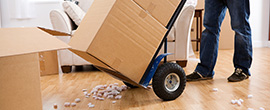Essential Tips to Streamline Your Packing Process for Moving
Posted on 19/05/2025
Essential Tips to Streamline Your Packing Process for Moving
Moving to a new home can be both an exciting and stressful experience. Whether you're relocating across the city or the country, one of the most challenging aspects is packing up your belongings. Creating an organized and efficient packing plan not only saves time but also reduces stress and prevents damage to your items. In this comprehensive guide, we'll share essential tips to streamline your packing process for moving to ensure a smooth and successful transition.

Why an Organized Packing Process Matters
Before diving into the actionable tips, it's important to understand why a streamlined packing process is so critical. Disorganized packing can lead to broken items, wasted time, and potential chaos during the unpacking stage. By prioritizing organization and efficiency, you'll not only protect your possessions but also make settling into your new home much easier.
Common Challenges During Packing
- Underestimating the time required
- Lack of proper packing materials
- Poor labeling
- Overpacking or spreading items between multiple boxes
- Forgetting important essentials or documents
Avoid these pitfalls by following our proven tips for streamlining your moving process.
1. Start With a Detailed Packing Plan
Inventory and Categorize Your Belongings
Before you even lift a single box, take time to make an inventory of your possessions. Go room by room and make a checklist of what needs to be packed, donated, or discarded. Group similar items together and decide what you'll need immediately after moving versus what can wait.
- Declutter before you pack: Set aside unwanted or unused items to sell, donate, or recycle. This reduces the number of items to pack and move.
- Use digital tools: Apps and spreadsheets can help you organize your inventory and monitor packing progress.
- Plan per room: Focus your packing efforts by tackling one room at a time.
2. Gather All Essential Packing Supplies
Having the right supplies makes the packing process for moving much more efficient. Scrambling for materials at the last minute can cause delays and frustration.
Key Packing Materials to Have On Hand
- Assorted sizes of sturdy moving boxes
- Packing tape and dispensers
- Bubble wrap and packing peanuts
- Stretch wrap for furniture and electronics
- Permanent markers for labeling
- Resealable plastic bags for small items
- Dish and glass packers for fragile kitchenware
- Furniture blankets for large or valuable items
Pro Tip: Always buy a few extra boxes and rolls of tape to avoid running out at the last minute.
3. Create a Strategic Packing Schedule
One of the most effective tips to streamline your packing process is to begin early and follow a systematic schedule. Packing everything at once can be overwhelming; spreading it out over weeks ensures thoroughness and reduces stress.
- Start with non-essentials: Pack items you rarely use first, such as out-of-season clothes, decorative pieces, and books.
- Work daily: Aim to pack a few boxes each day leading up to the move.
- Set deadlines: Assign packing goals by room and mark them on a calendar for accountability.
4. Label Boxes Clearly & Systematically
Clear labeling is essential for an organized move and hassle-free unpacking. Without proper labels, boxes can easily end up in the wrong room or will require opening multiple boxes to find one necessary item.
Effective Labeling Techniques
- Room designation: Write the room name on each box (e.g., "Kitchen," "Primary Bedroom").
- Contents list: Briefly name the major items inside (e.g., "Plates and Cups").
- Fragility alerts: Use "FRAGILE" for boxes containing breakables, and add arrows to indicate "This Side Up."
- Color-coding: Use colored labels or tape to quickly identify which boxes belong to which rooms.
Avoid generic labels like "Miscellaneous"--specificity saves time and frustration.
5. Protect Your Most Valuable and Fragile Items
Proper protective measures are a crucial part of an efficient packing and moving process. Use appropriate padding and packing techniques to safeguard against breakage and loss.
- Wrap breakables: Use bubble wrap, paper, or soft linens for glassware, mirrors, and electronics.
- Cushion boxes: Add crumpled newsprint or packing peanuts at the top and bottom of boxes for extra protection.
- Disassemble large items: Take apart furniture when possible and keep screws/bolts in labeled resealable bags taped to the furniture.
- Don't overload: Heavy items go in smaller boxes to avoid injury or breakage, while lighter items fill larger boxes.
6. Pack an Essentials Box for Moving Day
On moving day, you won't have time to dig through boxes for daily necessities. Pack a first-night essentials box for each family member with the must-have items you'll need right away.
What to Include in Your Moving Day Essentials Box
- Toiletries and medications
- A change of clothes and pajamas
- Important documents (IDs, passports, lease)
- Chargers and devices
- Snacks, water bottles, and basic utensils
- Towels and bedding
- Small toolkit (screwdrivers, tape, scissors)
- Pet food and supplies if applicable
This simple step is often overlooked but can vastly improve your first night in your new home.
7. Use Smart Packing Techniques
Streamlining the moving process is about more than just putting things in boxes. Using smart techniques can maximize space and provide additional protection for your belongings.
Space-Saving and Efficient Packing Methods
- Rolling clothes: Roll, rather than fold, clothing to save space in boxes and suitcases. You can also use clothing as padding for fragile items.
- Fill empty gaps: Use socks, towels, or linens to fill gaps in boxes and prevent shifting during transit.
- Nest items: Place smaller items inside larger ones to maximize box space (e.g., putting spices inside pots).
- Pack vertically: Place plates, books, and other flat items vertically to minimize surface area and reduce breakage risk.
Remember, a well-packed box should have no empty spaces but should not be overly heavy.
8. Involve All Family Members
Delegating tasks is a core component of an effective moving and packing process. Get everyone in the household involved, assigning age-appropriate tasks for children and specific rooms or items for adults.
- Children can help pack their toys or school supplies.
- Assign each person a room or category (e.g., books, kitchenware).
- Establish rewards or incentives for meeting packing milestones.
Tip: Turning packing into a collaborative effort makes the process faster and more enjoyable.
9. Take Photos of Complex Setups
Disassembling electronics or furniture? Use your phone to snap photos as you disconnect cables or take apart items. These visual references make reassembly much easier in your new space, ensuring you remember where each part or wire goes.
10. Stay Eco-Friendly Wherever Possible
Improving your packing process for moving can also benefit the environment. Choose eco-friendly practices to reduce waste:
- Opt for used boxes from friends, stores, or online marketplaces
- Use linens, towels, and clothing as padding instead of bubble wrap
- Recycle or repurpose packing materials after your move
- Donate unwanted items rather than throwing them away
11. Prepare for the Moving Company or Vehicle
If you're hiring movers or renting a truck, streamline moving day by ensuring packed boxes are ready and accessible. Group packages by room and stack them near the door or in a dedicated staging area. Clearly mark boxes for special handling or priority unloading.
Tip: Provide movers with a layout or legend for your new home to expedite unloading and placement.
12. Keep Important Documents Separate and Secure
Throughout the moving process, you'll accumulate a variety of essential documents--moving contracts, new home paperwork, identification, and more. Store all documents in a dedicated folder or accordion file. Keep this with you (not in the moving truck) for easy access and security.
13. Confirm All Utilities and Address Changes
Finalize your streamlined moving process by ensuring all utilities (electricity, water, gas, internet) are scheduled for transfer or installation. Update your address with banks, subscriptions, and official agencies to prevent missing mail or services.
14. Unpacking Efficiently After Arrival
The right packing process pays off during unpacking! Tackle your new home methodically:
- Start with the essentials box and bedrooms for quick comfort.
- Unpack kitchen and bathroom next for daily functionality.
- Set up furniture and large items before opening decorative or non-essential boxes.
Using your inventory and clear labels ensures you can prioritize unpacking quickly and efficiently.

Bonus Tips to Further Streamline Your Packing and Moving
- Notify key contacts: Tell friends, family, and service providers about your move in advance.
- Schedule moving services early: Reserve trucks and moving help ahead of time, especially during peak seasons.
- Take care of pets and plants: Arrange for transportation or temporary care for sensitive items and animals.
- Label cables and parts: Use tape or tags to mark chargers, electronics, and furniture hardware.
- Keep valuables close: Jewelry, cash, and personal keepsakes should travel with you, not in the moving truck.
Conclusion: Make Your Next Move Stress-Free
Packing doesn't have to be overwhelming or chaotic. By following these essential tips to streamline your packing process for moving, you'll not only reduce stress but also protect your belongings and make settling into your new home much easier.
The key to efficient packing is preparation: start early, stay organized, involve everyone, and don't cut corners with proper supplies and labeling. With these strategies, your next move will be smooth, efficient, and even enjoyable. Happy moving!










